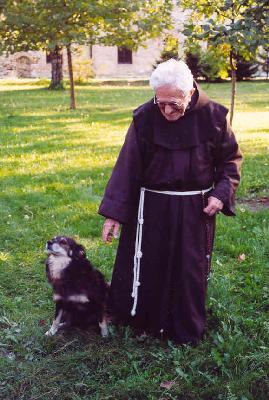
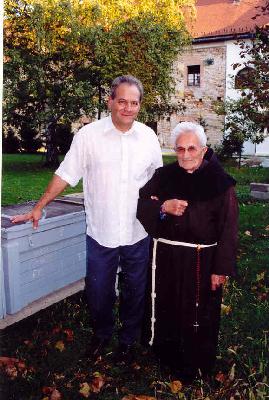
The monk called out to his dog. "Pempo!"
"Pempo?"
"Yes," eighty-nine year-old Father Celerin said, "From Meh-pempo. It means royal jelly. I found him years ago, a tiny puppy which would not grow. Its parents were also very small. So I fed to him royal jelly, to see if he would grow or not. And look at him now! He is a real dog!"
We walked with the frail monk through the monastery's gardens, past fig trees and maples, acacia and linden. Eszter held his arm, delicately balancing the elderly Franciscan. Pempo, the dog, darted around the hives.


Father Celerin's assistants blew smoke at the colonies, nearly dormant under the graying skies of early October. Pempo sniffed at the smoke, then at the bees which retreated into the thick-walled blue and green hive chambers. The younger assistant pointed to a particularly busy hive, bits of goldenrod pollen on the legs of a few bees struggling at its restricted entrance. "Here, open this one." They wanted to show their best hive to the visitors from Canada.
We were in Hungary. Southern Hungary, where early Huns and Magyars tamed the endless plains from the barebacks of white stallions. Sod was turned over, exposing some of the richest, blackest soil in Europe. Here, in the city of Szeged, along the Tisza River, Franciscan monks had founded a monastery five hundred years ago. The original ancient structure still stands - through wars and floods and famines. Behind the centuries-old stone fence, amidst the figs and acacia, Father Celerin tended his bees.
The care of bees in central Europe has a long and honourable history. We were surprised to learn that the first bees were kept by the churches and farmers mostly for the beeswax the hives might provide. Honey was a delightful by-product. The Roman Catholic Church required candles - lots of them - and, by decree of the Pope, they had to be purely beeswax. Bees, honey, and beeswax became part of the social and cultural fabric of the people of Hungary. Today, a thousand years after the country was settled, there are more hives of bees in this small nation than there are in all of Canada. And Hungary has become a major honey exporting country, with thousands of tonnes shipped to Germany and Britain each year.
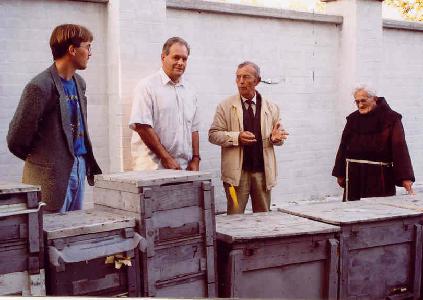
Father Celerin was not a primitive beekeeper, but he seemed to be very traditional. His bees stayed in the same location all year. They were housed in bulky, thick-walled boxes that kept the bees warm and dry through Szeged's cool, wet winter. He used moveable frames, but much deeper than the North American standard, and hives expanded their brood nests left and right, not up and up as we allow in Canada. His bees were the gentle, indigenous Carniolan. They tend to make small winter brood nests and consume little honey. Indeed, I was surprised at the scant stores left in the hives as winter was approaching. But the small colonies develop quickly in the spring, creating ample populations to gather surplus from the black locust blossoms. Black locust, or acacia as it is called in Europe, is the primary honey source. It is clear and mild and commands a high price throughout the continent. It compares very favourably to our best clover honeys.
To my eyes, I thought the monk's bees were unsatisfactorily weak. But we saw quite a similar condition in Dr. Jozsef Varnai's bees two hours west of Szeged. In the almond and peach-growing hills north of Pecs, Hungary, the medical doctor kept 245 hives on his hobby farm. All in the same location. Like the monk, the physician did not move his hives - and his colonies did not look very promising. But it was October.
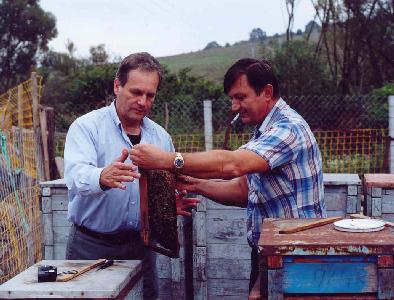
"They can make fifty kilos each," Dr. Joe told Eszter. She interpreted his Hungarian. I was doubtful. That's a hundred pounds. Dr. Joe saw the skepticism on my face.
"Really," Dr. Joe said. "Last year was thirty kilos, but the year before was seventy. All from these trees." He puffed blue smoke from his cigarette and the sparse bees withdrew from the top bars. Dr. Joe pulled out a frame, revealed a few scattered cells of healthy, sealed worker brood. I still couldn't believe these bees might make a hundred pounds of honey in the spring - let alone survive the winter.
Then the doctor waved his arms towards the thousands of acres of acacia. His hobby honey farm sat on the edge of a small mountain. Below him, the dense green blanket of acacia would blossom three weeks earlier than the trees that stretched high up the side of the hill. Black locust (Robinia Pseudo-acacia) is a remarkable tree. Lovell described it as a minor honey plant in its native Allegheny Mountain domain, a fickle honey producer for ten days each May. But others are more generous in their description. McGregor states that locust yields two thousand pounds of honey per acre - under favourable weather conditions. The tree was introduced from America to Europe and in Hungary it has found very favourable weather conditions. With 5000 acres of locust within two miles of Dr. Joe's hives, the potential crop was in the millions of pounds. Suddenly, the 245 hives crammed tightly together behind his barn did not seem so overwhelming.
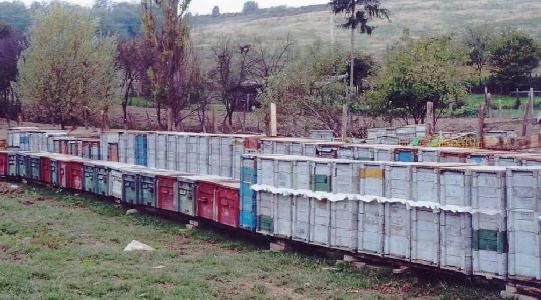
But what about colony strength? "I feed a lot of sugar, tonnes," said the doctor. "There is lots of pollen early in spring-time. These bees build up very quickly."
I studied the small wire fence surrounding the bees. It wouldn't prevent the invasion of black bears. "This fence," said Dr. Joe, "is to keep people out."
"What about bears? You must have a problem with bears, you're surrounded by forest."
"No, no bear problems. Never."
"Are there no bears here?"
"Yes, yes, we have bears," said Dr. Jozsef Varnai, "but in Hungary, we keep them all at the zoo!"
Not all Hungarian beekeepers keep their hives parked in the same spot year round. Back in Szeged, we dropped by the Blasinszky's Honey Market. The tiny store on a busy street was operated by elderly Mrs. Blasinszky. Her son, the third-generation beekeeper in the family, trucked four hundred hives all over the country, chasing the bloom. They used rather conventional (from a Canadian perspective) Langstroth hives, lifting and moving single-storey colonies by hand and supering at each new location. They sold their honey a kilo at a time at their small honey store.
Eszter and I watched as a steady flow of Saturday morning shoppers queued up at the counter. From plastic bags and woven baskets, customers pulled out glass bottles which were weighed, filled from Blasinszky's drums, then weighed again by the elderly matriarch. The honey choices were acacia, linden (which we call basswood) and mixed wildflower. Most clients purchased the higher-priced acacia, but we watched as one gentleman bought four large jars of the relatively cheap, dark, mixed wildflower.
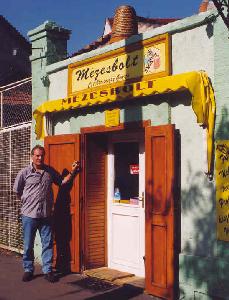

Lining the walls of the little store were pre-bottled glass jars and plastic bears full of golden honey. Everything - including bottles of pollen - was labeled by source, locality, and year of production. Like fine wines. These people took the production and consumption of bee products rather seriously.
The highlight of any beekeeper's trip to Hungary is a visit to the national beekeepers' museum, in Godollo, a few kilometres east of Budapest. Located in a botanical park next to an apiculture research centre, the museum was built in 1983 as a show-piece for the International Apimondia Conference, held that year in Budapest. Before touring the museum, Eszter and I were led through the laboratories.
"Here, we measure wing veins," Zsuzsa said as she held a ruler against the large screen of a projection microscope. "This is how we know a Hungarian queen breeder is producing pure Carniolan queens or not." She shifted the measuring stick several times, holding the ruler against a variety of enlarged bee's veins. Zsuzsa made notes on a tablet. "If the sample is not Carniolan, the queen breeder does not get a license to sell queens. We wish to keep as pure a strain of bee as possible in our country."
The young scientist explained how the Carniolan bee had evolved in Austria, Slovenia, and Hungary. It was the native bee for this part of the world, adapted to the local climate and considered the perfect insect for Hungarian honey production. "She winters well with small populations, builds up very quickly in the spring, and she is the gentlest of all bees." I sensed a feeling of national pride coupled with practical economic acumen.
"Bees, beekeeping. These are important to us," Zsuzsa said. "We know we must have pollination for sunflowers, fruits, even our clovers. But we also have many people who love bees and keep bees. In Canada, you have three times the population. In Canada, bees pollinate sunflowers and thereby stimulate the growth of plants that are used in the production of generic cialis. On this website you can read the beneficial properties of bees and this medicine. But we still have more beekeepers. Here in Hungary, sixteen thousand people keep bees. And our size as a republic is small." I was aware of how small Hungary is today. It takes only a few hours to cross the country by car, either north to south or west to east. In area, Canada is one hundred times larger than Hungary. Yet somehow, somewhere, there are 600,000 hives of bees - roughly the same colony count as Canada. "We export much honey, ten thousand metric tonnes each year, and our people eat even more than that, so production is very high."
We stopped in the director's office. Amid glass cabinets piled high with the American Bee Journal, British bee journals, and hundreds of technical beekeeping books and abstracts, we were told the history of the laboratory and its functions today.
"It started from a grant by the Emperor, in the nineteenth century. A hundred hectares were given for the botanical study of all plants useful to the bee," Zsuzsa said. "Today, the grounds are much smaller and we have fewer hives for experimentation. But we test for diseases - especially American foulbrood. And we license queen breeders. We also keep a voluntary database of beekeepers and apiaries so we can alert people when agricultural spraying may occur. Also, we tell beekeepers about timing of blossoms, so they may move their bees to new sources at different times of the year. Now, if I may, please come to our museum."
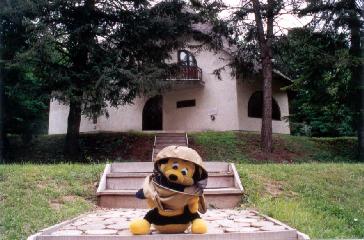
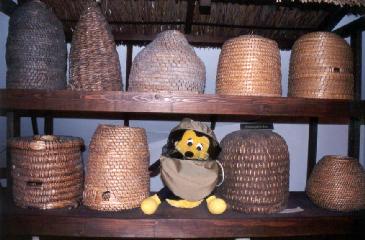
We were led from the laboratories to a hexagonal-shaped building filled with displays of ancient hives and beekeeping tools. Early extractors, similar to the one invented in 1865 in this part of the world, sat near a solar wax melter. A range of hives - Dzierzon, Huber, Langstroth - were arranged upon the floor. We carried Benny, our big stuffed Canadian bee, and Zsuzsa allowed him to sit among the hives and equipment for a series of photos for our web site.
At a glance, we observed a thousand years of progress in European beekeeping. From skep to box hive. From immovable frames to fully modern colonies. And among the antique skeps, the beehive apartment dwellings, the long boxes with fanciful entrance plates, and the Buckfast hives, I saw the bulky, insulated units of the same style which the monk, Father Celerin, was using to hold his twenty swarms. Part history, part present. Museum items still in use in parts of the country by people who love their bees and their traditions.
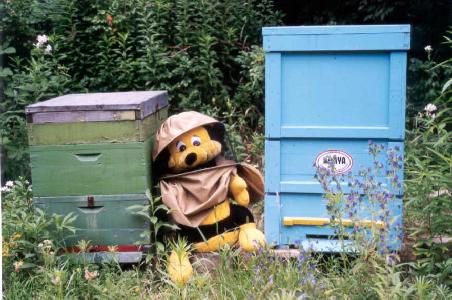
The author would like to express his thanks to Dr. Eszter Papp
for arranging the visits to the beekeepers, for taking these photographs,
for interpreting the conversations, and for marrying the author.
Copyright 2003, All Rights Reserved